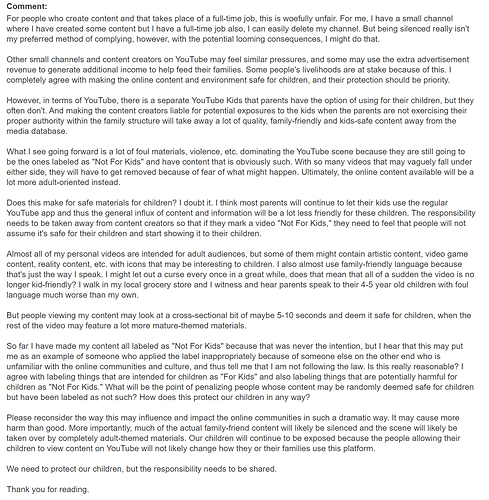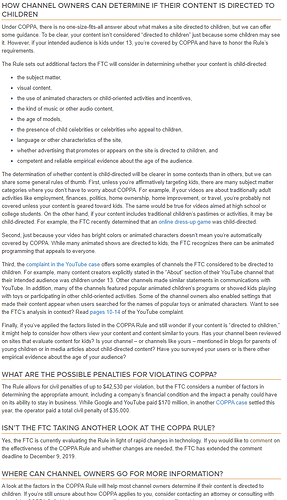What if I told you the people that are trying to change this may be trying to literally keep their job?
What if I told you that this is about getting fucked by the FTC, not Youtube? The FTC has stated they will go after the content creators, NOT YOUTUBE.
What if I asked you to name one other video hosting website? The first one I can think of is Pornhub.
How much money do you sincerely think it takes to run a video hosting site? I honestly don’t know, but I do know that server equipment costs in the thousands and the network needed to fully accomplish such a thing is flipping huge. Even with as large as youtube and Alphabet is, I believe Youtube is actually a net loss.
This is about the FTC modifying the COPPA rule (it is already a rule in place, they are just updating it.) it is entirely the FTC’s rule, not youtube’s. Youtube is required to comply. What is stopping the FTC from applying this to just about every other service if and when they exist?
I feel like this may be an issue with people not understanding that the problems lives within the fact the new rules are vague to the point of covering just about fucking everything. This isn’t about Youtube itself, this is about protecting those that use youtube to bring YOU quality content and the FTC’s rule that could hit them with up to $42,000 PER VIDEO. For something you may be more aware about, that is more than the average student loan debt in America. That is also approximately the same amount as a freaking hospital bill for something minor. Imagine getting getting 3 or 4 hospital bills because you legitimately do not know if your content constitutes as “primarily directed towards children” because you can’t interpret the law since it’s vague.
To understand the creator side. Imagine if you got told you were going to lose up to 90% of what you make at your job because of a new proposed rule. Would you be upset?
They issued a blog post about it. Here’s their response:
In text
HOW CHANNEL OWNERS CAN DETERMINE IF THEIR CONTENT IS DIRECTED TO CHILDREN
Under COPPA, there is no one-size-fits-all answer about what makes a site directed to children, but we can offer some guidance. To be clear, your content isn’t considered “directed to children” just because some children may see it. However, if your intended audience is kids under 13, you’re covered by COPPA and have to honor the Rule’s requirements.
The Rule sets out additional factors the FTC will consider in determining whether your content is child-directed:
the subject matter,
visual content,
the use of animated characters or child-oriented activities and incentives,
the kind of music or other audio content,
the age of models,
the presence of child celebrities or celebrities who appeal to children,
language or other characteristics of the site,
whether advertising that promotes or appears on the site is directed to children, and
competent and reliable empirical evidence about the age of the audience.
The determination of whether content is child-directed will be clearer in some contexts than in others, but we can share some general rules of thumb. First, unless you’re affirmatively targeting kids, there are many subject matter categories where you don’t have to worry about COPPA. For example, if your videos are about traditionally adult activities like employment, finances, politics, home ownership, home improvement, or travel, you’re probably not covered unless your content is geared toward kids. The same would be true for videos aimed at high school or college students. On the other hand, if your content includes traditional children’s pastimes or activities, it may be child-directed. For example, the FTC recently determined that an online dress-up game was child-directed.
Second, just because your video has bright colors or animated characters doesn’t mean you’re automatically covered by COPPA. While many animated shows are directed to kids, the FTC recognizes there can be animated programming that appeals to everyone.
Third, the complaint in the YouTube case offers some examples of channels the FTC considered to be directed to children. For example, many content creators explicitly stated in the “About” section of their YouTube channel that their intended audience was children under 13. Other channels made similar statements in communications with YouTube. In addition, many of the channels featured popular animated children’s programs or showed kids playing with toys or participating in other child-oriented activities. Some of the channel owners also enabled settings that made their content appear when users searched for the names of popular toys or animated characters. Want to see the FTC’s analysis in context? Read pages 10-14 of the YouTube complaint.
Finally, if you’ve applied the factors listed in the COPPA Rule and still wonder if your content is “directed to children,” it might help to consider how others view your content and content similar to yours. Has your channel been reviewed on sites that evaluate content for kids? Is your channel – or channels like yours – mentioned in blogs for parents of young children or in media articles about child-directed content? Have you surveyed your users or is there other empirical evidence about the age of your audience?
It’s still vague in my opinion. I understand they want to make it flexible, but this is also very open ended.





